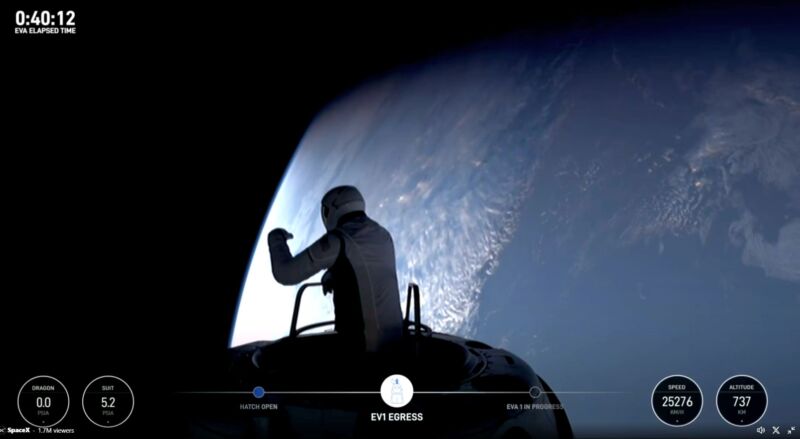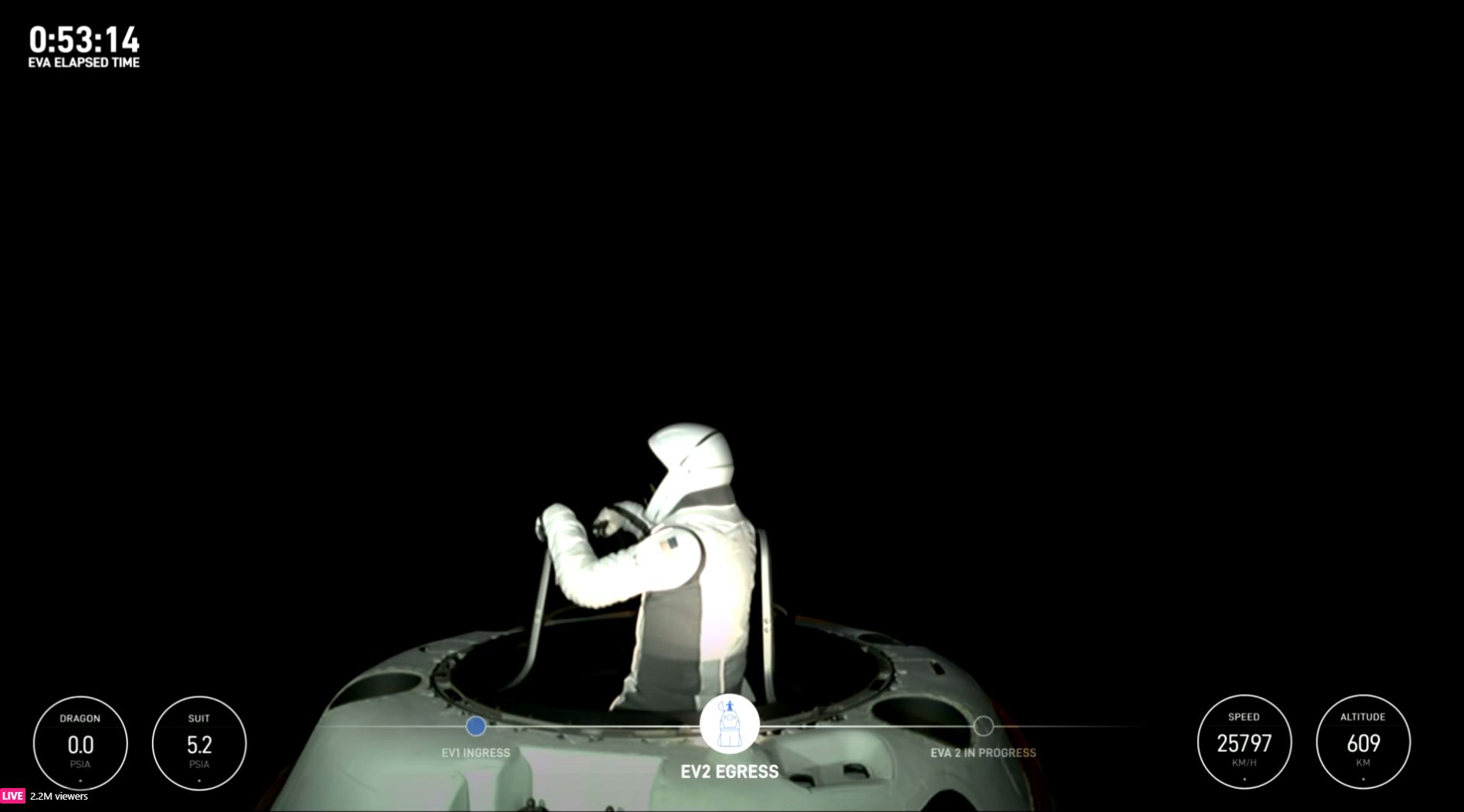
SpaceX webcast
The Polaris Dawn mission took a firm step into the future on Thursday morning when two private citizens, Jared Isaacman and Sarah Gillis, briefly ventured outside their Dragon spacecraft.
Although each only spent about eight minutes outside the capsule, the spacewalk was unquestionably a major success for SpaceX and the four astronauts flying in orbit. This marked the first time that a private company, SpaceX, conducted a spacewalk. Funded by Isaacman, the mission spurred a frenetic two-year period of spacesuit development, testing, and simulations by the California company to reach Thursday’s remarkably smooth operations.
Isaacman emerged from Dragon at 6:52 am ET (10:52 UTC) as the spacecraft passed near Australia on the planet below. A billionaire, entrepreneur, and avid pilot, Isaacman paused for just a moment as he stood on the edge of eternity and looked back at Earth.
“Back at home, we all have a lot of work to do, but from here, Earth sure looks like a perfect world,” he said.
How it unfolded
After nearly two weeks of weather delays, the Polaris Dawn mission launched early on Tuesday morning aboard a Falcon 9 rocket. The crew, Isaacman, pilot Scott “Kidd” Poteet, and SpaceX engineers Anna Menon and Sarah Gillis, cruised to an altitude above 1,400 km on the mission’s first day before returning to a lower altitude in preparation for Thursday morning’s spacewalk.
Just a couple of hours after the launch, the crew began a pre-breathe process to begin acclimating their bodies to a lower pressure. At the beginning of cabin depressurization on Thursday morning, the cabin pressure was 8.6 psi, slightly higher than the air pressure at the base camp at Mount Everest. (Sea-level pressure on Earth is 14.7 psi.) At this point, the four astronauts were breathing pure oxygen through their suits.
Depressurization of the Dragon spacecraft, which does not have an airlock, took about 30 minutes. By the time the Dragon’s cabin was in a vacuum, the pressure inside the astronauts’s suits was about 5 psi, which is slightly less than the summit of Mount Everest. At this point, Isaacman moved to manually open the hatch and climb upward into space.
Connected to Dragon by an umbilical providing oxygen and thermal control, Isaacman purposefully ran through a series of tests of the spacesuit’s mobility. He tested hand and body movements and the ability to use tools. With just a minute left before he had to come back inside Dragon, Isaacman again took stock of his surroundings. Below, Earth was disappearing into darkness as Dragon soared over New Zealand.

With the Earth in shadow below, Sarah Gillis took her stroll outside.
SpaceX webcast
“It’s gorgeous,” he said.
After Isaacman climbed back down inside, he was followed by Gillis, a SpaceX engineer who worked on spacesuits among other programs at the company. She performed a similar battery of tests. Like Isaacman, Gillis extended most of her body outside Dragon, with only her lower legs still inside the spacecraft. At 30 years old, she is the youngest person to walk in space.
By 7:58 am ET, it was all over. The entire spacewalk, from cabin depressurization to the operations by Isaacman and Gillis to the re-pressurization of Dragon, had taken just 1 hour and 46 minutes.
“Today’s success represents a giant leap forward for the commercial space industry and NASA’s long-term goal to build a vibrant US space economy,” said NASA Administrator Bill Nelson in a statement after the spacewalk concluded.
What’s the big deal?
One might reasonably ask why this is such a big deal. After all, Soviet cosmonaut Alexei Leonov performed the first spacewalk back in 1965. He spent 12 minutes outside his Voshkod spacecraft. Since that time, 263 people from dozens of countries have performed spacewalks. In 2001, NASA astronauts Susan Helms and James Voss performed a spacewalk that lasted 8 hours and 56 minutes.
In some sense, then, Isaacman and Gillis were trodding a well-worn path that dates back nearly six decades.
And yet, it does matter—quite a lot.
Something similar could be asked about the Falcon 9 rocket’s debut launch in 2010. Before then, nations, and even some large private contractors funded by governments, had built medium-lift rockets. In its earliest iteration, the Falcon 9 was just another rocket flying into orbit. But here’s the difference. Fourteen years later, the privately developed Falcon 9 has revolutionized the launch industry by demonstrating rapid reusability. It will launch more than 100 times this year, something no government or company has ever done before.
Now imagine where SpaceX and this spacesuit could be 14 years from today. The first Falcon 9 rocket has gone through four major revisions, more than doubling its payload capacity. So, too, will this spacesuit. It’s not too difficult to imagine a world in which dozens of people launch on Starship and take similar spacewalks in orbit. Future versions of these spacesuits will almost certainly walk on the Moon, and one day, Mars.
That’s why this is not overblown. These tentative and brief spacewalks potentially represent a critical step in humanity’s expansion into the Solar System. And it happened this morning.
